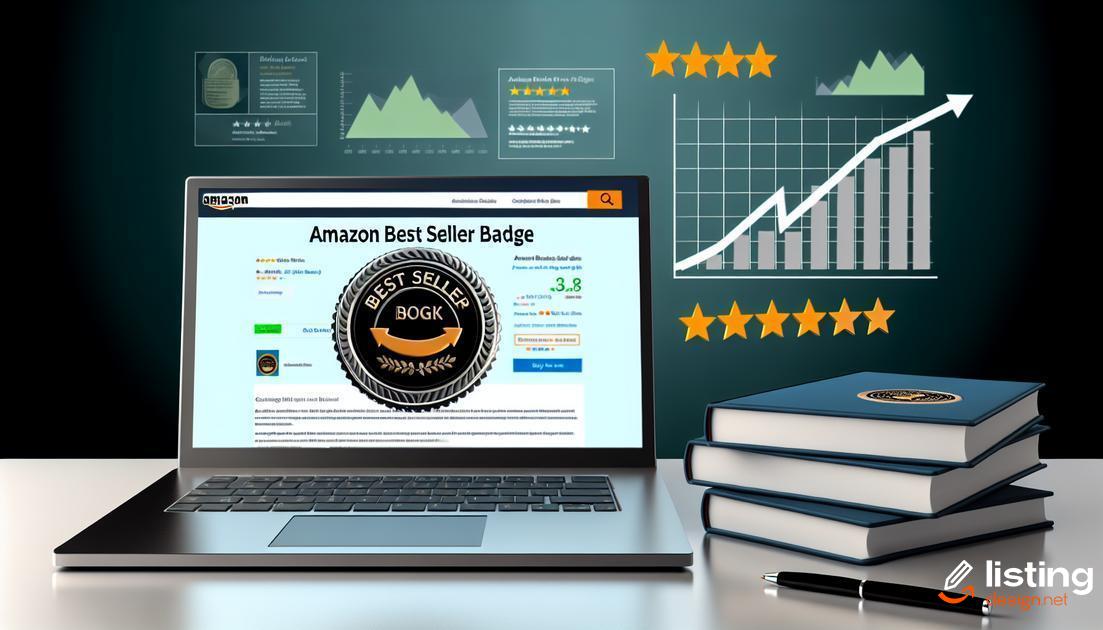Securing the Amazon Best Seller Badge can significantly boost your product’s visibility and sales. This coveted badge is awarded to products that consistently rank at the top of their categories. In this article, we will explore what the Amazon Best Seller Badge is, why it is important, and the criteria for earning it. You’ll also learn practical steps to optimize your product listings and improve sales performance.
Table of Contents
What is the Amazon Best Seller Badge?
The Amazon Best Seller Badge is a distinct orange badge that appears on product listings on Amazon. This badge is awarded to products that are the top-selling items in their respective categories. The badge indicates that the product is popular and trusted by a large number of buyers.
The badge can be seen on the product’s detail page and in search results, making it highly visible to potential buyers. When customers see this badge, it acts as a signal of quality and reliability, encouraging more purchases.
Gaining the Best Seller Badge can significantly increase a product’s visibility and credibility. This badge is updated hourly, meaning that it reflects the latest sales trends. Products that consistently perform well are more likely to retain the badge over time.
Why is the Best Seller Badge Important?

The Best Seller Badge on Amazon holds significant value. It serves as a trust signal to potential buyers, indicating that the product is popular and has a proven track record of sales. This badge can substantially increase the visibility of your product in search results, which in turn can lead to higher click-through rates and more sales.
Customer Trust
When shoppers see the Best Seller Badge, they are more likely to trust the product and the brand. This trust can shorten the decision-making process and encourage quicker purchases.
Increased Visibility
Products with this badge are often featured prominently in Amazon’s search results and category listings, giving them an edge over competitors. The boost in visibility can lead to more organic traffic and increased sales.
Competitive Advantage
In a crowded marketplace, the Best Seller Badge helps your product stand out. It’s a clear indicator of quality and popularity, which can sway undecided buyers in your favor. Understanding the importance of the Best Seller Badge is crucial for any seller looking to increase their sales and market presence on Amazon.
How Does Amazon Determine Best Sellers?
Amazon employs a sophisticated algorithm to determine its best sellers in each category. This algorithm continually monitors and updates based on various factors, ensuring that the rankings are as current and accurate as possible. Sales performance is the primary factor that influences these rankings. Sales rank, also known as Best Sellers Rank (BSR), is a numerical representation of a product’s sales performance within its category. The lower the BSR, the better the sales performance.
Another critical aspect is recent sales velocity. This refers to how quickly a product has been selling over a short period. A surge in sales can quickly improve a product’s ranking, whereas a decline can have the opposite effect. Additionally, the time of day when sales occur and the frequency of these sales are taken into account to further refine the algorithm’s accuracy.
Moreover, Amazon evaluates historical sales data to establish patterns and trends. This helps in differentiating between short-term spikes and consistent performers in the marketplace. Therefore, a product that has consistently sold well over an extended period is more likely to maintain a strong position in the rankings compared to one that experiences only temporary boosts in sales.
Customer reviews and ratings also play a role in determining best sellers. High ratings and positive reviews can influence future customers’ purchasing decisions, indirectly affecting sales velocity and, consequently, the product’s ranking. However, while reviews are important, they are not the primary criterion for the BSR.
Finally, availability and inventory levels are considered. Products that frequently go out of stock or have limited availability may struggle to maintain their ranking, as consistent availability is crucial for sustaining high sales volumes.
The Impact of the Best Seller Badge on Sales

The Amazon Best Seller Badge can significantly influence your sales. This badge serves as a strong signal to customers that a product is popular and well-reviewed. When a product earns this badge, it gains increased visibility on search result pages and higher conversion rates.
Additionally, products with the Best Seller Badge often see a rise in click-through rates. Consumers tend to trust best sellers more, leading to more traffic to product pages. This boost in traffic coupled with the badge’s credibility can make a product more attractive, ultimately improving its sales performance.
The badge can also impact your organic ranking on Amazon. Products that are frequently bought and positively reviewed tend to rank higher in search results. This higher ranking further drives sales, creating a positive feedback loop.
Moreover, the Best Seller Badge can create a sense of urgency and trust among buyers. Shoppers are more likely to purchase a product that is identified as a best seller, as it gives assurance of quality and popularity. This social proof element significantly impacts purchasing decisions.
Criteria for Earning the Best Seller Badge
To earn the Amazon Best Seller Badge, several key criteria must be met. First, your product needs to achieve high sales volume within its category. Amazon monitors sales data closely and updates rankings frequently, meaning your product must be consistently outperforming competitors in terms of sales.
Price Competitiveness
is another crucial factor. Your product must offer great value compared to similar items. This doesn’t necessarily mean having the lowest price, but rather the best value proposition.
Customer Reviews and Ratings also play a significant role. Products with a high number of positive reviews are more likely to be awarded the Best Seller Badge. Ensure your product delivers high quality to encourage positive feedback.
The use of appropriate keywords is essential in securing visibility. Including relevant search terms in your product title, description, and backend keywords can improve your product’s search ranking, leading to increased sales.
Inventory management is equally important. Running out of stock can negatively impact your sales velocity and ranking, so always maintain healthy inventory levels.
Regularly monitor your competitors and adjust your strategies accordingly. Use tools to track competitors’ pricing, keywords, and sales tactics to stay ahead.
Steps to Achieve the Amazon Best Seller Badge

To earn the Amazon Best Seller Badge, start by selecting a profitable niche with high demand and reasonable competition. Research relevant keywords using tools like Amazon’s search bar, Jungle Scout, or Helium 10. Once you have identified the right keywords, incorporate them naturally into your product title, bullet points, and description.
Next, focus on creating high-quality, detailed product listings. Use clear and professional images, ideally showing the product from multiple angles and in use. Ensure that the product description is informative, engaging, and highlights the main features and benefits.
Additionally, setting a competitive price point can make a significant difference. Analyze competitors’ pricing and adjust yours to be attractive yet profitable. Promotional strategies like limited-time discounts can also help boost initial sales, which is crucial for ranking.
Customer reviews and feedback are critical. Encourage satisfied customers to leave positive reviews and address any negative feedback promptly and professionally. Offering excellent customer service can lead to a higher overall product rating, influencing the Best Seller ranking positively.
Use Amazon Sponsored Ads to promote your products. Investing in pay-per-click (PPC) advertising can increase visibility, driving more traffic to your listings and enhancing sales. Top-notch ad campaigns can significantly expedite the process of achieving the Best Seller Badge.
Lastly, monitor your product performance through Amazon Analytics. Utilize the reports to understand consumer behavior, sales trends, and adjust your strategy accordingly. Keeping track of these metrics helps in making informed decisions to maintain and enhance sales performance.
Optimizing Product Listings for Better Sales
Enhancing your product listings is crucial for securing the Amazon Best Seller Badge and driving sales. Start by conducting thorough keyword research to identify high-volume search terms relevant to your product. Strategically include these keywords in your product title, bullet points, and description.
Ensure your product title is clear and descriptive, highlighting the most important features and benefits. For example, instead of a simple title like “Notebook,” opt for something more descriptive like “Stainless Steel Spiral Notebook with Waterproof Pages – 200 Sheets”.
High-quality images are essential. Use multiple images that showcase your product from various angles, including zoomable options. If possible, include a video demonstrating the product’s use and benefits.
Your bullet points should be concise and informative, outlining the key features and advantages of your product. Use HTML tags such as bold to highlight crucial information. Each bullet point should focus on a single feature or benefit to facilitate easy reading.
Comprehensive product descriptions are imperative. Break down complex information into smaller, digestible sections using subheadings. Ensure the content is both engaging and informative, emphasizing why your product stands out from the competition.
Leverage backend search terms. Use all available characters to include various keyword combinations that potential customers might use when searching for your product. This practice can significantly improve your product’s visibility.
Encourage customer reviews and provide exceptional customer service. Positive reviews not only enhance your product’s credibility but also influence potential buyers. Consider following up with customers post-purchase to gather feedback and address any issues promptly.
Regularly monitor and update your listings based on performance metrics available in Amazon Analytics. This allows you to make data-driven decisions and continuously optimize your product listings for better sales.
The Role of Customer Reviews and Ratings

Customer reviews and ratings play a critical role in achieving the Amazon Best Seller Badge. When shoppers see numerous positive reviews, it helps build trust and credibility, encouraging them to purchase your product over competitors’.
Positive reviews can significantly enhance your product’s visibility. They contribute to higher conversion rates, which directly influence your sales rank on Amazon. Higher sales rank increases the likelihood of getting the Best Seller Badge.
Encouraging customers to leave honest feedback is essential. Engage with your customers post-purchase and send follow-up emails requesting reviews. Make sure to address any negative reviews promptly and professionally to maintain a high rating.
Additionally, having a steady stream of fresh reviews can help maintain your product’s relevance and attractiveness. This continuous flow of feedback not only aids in securing the badge but also in sustaining it in the long run.
Leveraging Sponsored Ads to Boost Sales
One effective way to increase your sales on Amazon and boost your chances of achieving the Best Seller Badge is by leveraging sponsored ads. Sponsored ads, offered through Amazon’s advertising platform, allow sellers to promote their products to a larger audience, giving them higher visibility within the platform. This can lead to a significant increase in traffic and potential sales.
Targeted Advertising: With sponsored ads, sellers can target specific keywords and demographics, ensuring that their products are shown to the most relevant potential buyers. This targeted approach helps maximize the return on investment (ROI) by focusing ad spend on the audience most likely to convert.
Ad Formats: Amazon provides various ad formats including Sponsored Products, Sponsored Brands, and Sponsored Display ads. Each format offers unique benefits and can be strategically used to achieve different marketing goals. For instance, Sponsored Product ads are great for directly increasing product visibility, while Sponsored Brand ads can build brand recognition.
Boosting Product Rankings: Consistent performance from sponsored ads can also help improve a product’s organic ranking over time. When a product receives increased visibility and sales through ads, it can lead to better search rankings, further enhancing the likelihood of earning the Best Seller Badge.
Utilizing data from ad campaigns is crucial. Regularly analyze your ad performance to understand which keywords and strategies are driving the best results. Adjusting your ads based on this data helps in optimizing the effectiveness and efficiency of your ad spend.
Utilizing Amazon Analytics and Reports

Amazon Analytics and Reports offer invaluable insights into your sales performance and customer behavior. Monitoring these metrics allows you to understand which products resonate with your audience and which strategies are driving sales. Key reports to focus on include the Sales Dashboard, which gives you a quick snapshot of your revenue and order volume, and the Business Reports, which break down sales by SKU, ASIN, and category.
Performance data can guide your efforts in optimizing listings and marketing strategies. For example, analyzing Conversion Rates can help you identify listings that need improvement. Similarly, Customer Retention Metrics can indicate how well your products meet customer expectations.
Using Amazon A/B Testing, you can experiment with different listing elements such as titles, images, and descriptions to see what performs best. This data-driven approach ensures that you continually refine your product listings for maximum impact.
Inventory Reports can also reveal trends in stock levels and order patterns, enabling you to manage inventory more effectively and avoid stockouts or overstocking. Leveraging this data ensures that you meet customer demand efficiently.
Overall, Amazon Analytics and Reports are crucial tools for any seller aiming to achieve and maintain the Best Seller Badge. By making informed decisions based on solid data, you can optimize your sales strategy and improve your chances of earning this coveted badge.
Common Mistakes to Avoid
One of the most common mistakes sellers make is failing to optimize their product listings. This includes neglecting keyword research, which can significantly impact your product’s visibility on Amazon. Avoid using irrelevant keywords or keyword stuffing as it can lead to a poor customer experience and lower your ranking.
Another mistake is not utilizing high-quality images. Low-resolution images or lack of multiple images can deter potential buyers. Always use clear, high-resolution images from different angles and include lifestyle photos to help customers visualize the product’s use.
Ignoring the importance of competitive pricing can also be detrimental. Make sure to regularly check competitors’ prices and adjust accordingly while maintaining a healthy profit margin. Overpricing or underpricing your products can both negatively affect your sales and chances of obtaining the Best Seller Badge.
Poor inventory management is another common pitfall. Running out of stock can result in losing the Best Seller badge and decrease your product’s ranking. Implement a reliable inventory management system to ensure you can meet demand.
Lastly, not paying attention to customer reviews and feedback can hurt your sales. Negative reviews and low ratings can deter potential buyers and decrease your chances of earning the Best Seller Badge. Actively monitor and respond to customer feedback, address issues promptly, and encourage satisfied customers to leave positive reviews.
Case Studies: Success Stories

Examining real-world examples can provide valuable insights into successfully earning the Amazon Best Seller Badge. These case studies illustrate various strategies implemented by different sellers to achieve this coveted status.
Case Study 1: Organic Growth
One seller noticed a significant boost in sales by improving their product listing’s SEO. They focused on keyword optimization, crafting detailed yet concise product descriptions, and utilizing high-quality images. This approach not only increased visibility but also drove organic traffic to their listing, ultimately earning them the Best Seller Badge within a few months.
Case Study 2: Effective Use of Sponsored Ads
Another seller leveraged Amazon Sponsored Ads to target highly relevant keywords. By conducting thorough keyword research and utilizing Amazon’s Pay-Per-Click (PPC) advertising, they significantly enhanced their product visibility. The careful management of ad campaigns led to higher conversion rates and helped this seller achieve the Best Seller Badge efficiently.
Case Study 3: Leveraging Customer Reviews
A different approach was taken by a seller who focused on customer feedback. They actively engaged with customers post-purchase to encourage reviews and addressed any issues promptly. Over time, the accumulation of positive reviews and ratings improved their product ranking, enabling them to attain the Best Seller Badge through customer trust and satisfaction.
These success stories underline the importance of consistent and strategic efforts in various areas such as listing optimization, advertising, and customer engagement. By analyzing these cases, other sellers can identify effective methods tailored to their unique products and target markets, paving their way towards the Amazon Best Seller Badge.


